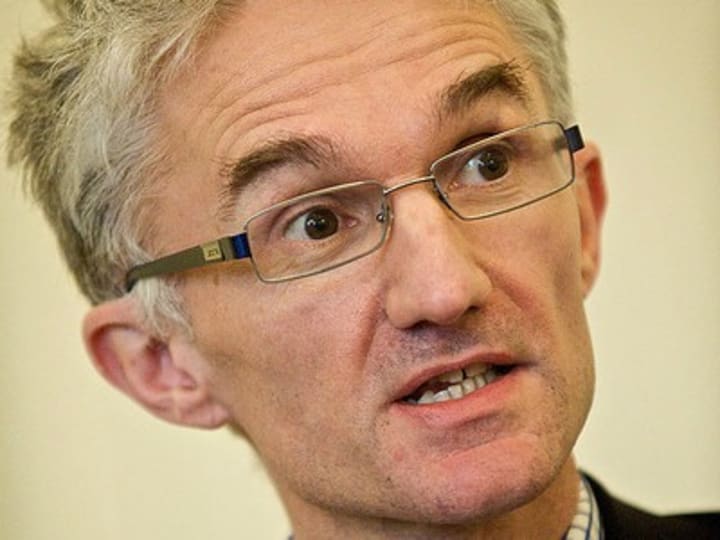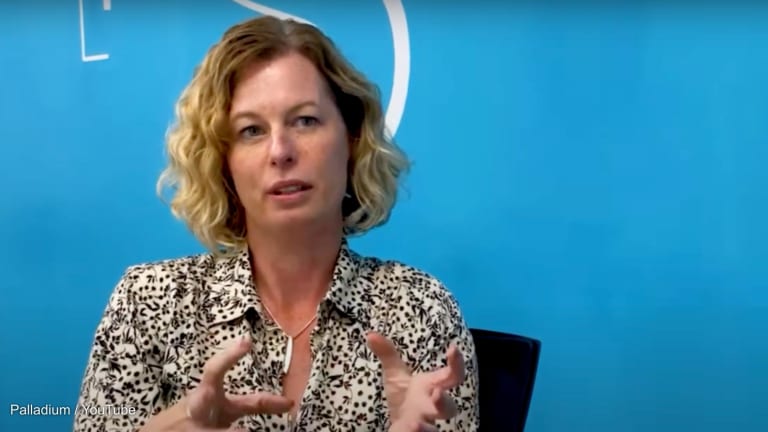
On a coffee table in Mark Lowcock’s wood-paneled Westminster office sit two cylindrical glass vases filled to the brim with black nuggets of boiled sugar. Tom-Toms, a popular Nigerian sweet, are delivered in regular consignments by a senior Department for International Development official to satisfy the sugar cravings of his London boss. Lowcock laughs at the notion that his favor might be bought so cheaply. When I suggest that Nigeria would be in vastly better health if the endemic corruption within its public administration could be reduced to an exchange of sugary sweets, he readily concurs.
Even in small talk, there is no mistaking the seasoned public official who has got his message straight. His concise, occasionally staccato, delivery seems appropriate to the job. The global development industry is entering what might, broadly, be termed a period of late adolescence – after the far-reaching reforms introduced in the 1990s. Donors are grappling with a new and altered sense of their own responsibilities. In Organization for Economic Cooperation and Development member nations at least, executives from leading agencies are looking for new ways to articulate the evolving methodology of development. From their hotchpotch of policy goals and evaluation techniques, Lowcock has honed a distinctive position of relative clarity.
If DfID had a manifesto, its defining theme would be value-for-money – a mantra taken up by British ministers and development officials. The new emphasis cannot credibly be ascribed to individuals, but in any practical sense Lowcock is the man behind the movement. In June this year, DfID’s permanent secretary completed his first year at the helm of the official U.K. aid agency. His departmental budget, which stood at about £7.7 billion ($11 billion) in 2010-11, is both carrot and stick – a prized resource for contractors, and a means to exert leverage inside the industry and its institutions.
By 2014, DfID’s budget will rise to about £12 billion – in line with OECD Development Assistance Committee target of 0.7 percent of gross national income which was also adopted by the United Nations back in October 1970. Yet, even that hard-won consensus can seem anachronistic. In March 2012, the economic affairs committee of the House of Lords, Britain’s upper parliamentary chamber, unanimously opposed proposals to enshrine the 0.7 percent target in British law. Urging flexibility “to respond to changing circumstances at home and abroad,” their report anticipated that a fixed target for aid spending would conflict with other priorities.
“We believe that development aid should be judged by the criteria of aid effectiveness and value for money, not by whether a specific arbitrary spending target is reached,” said Lord MacGregor, chairman of the House of Lords economic affairs committee.
Behind his polite and soft-spoken demeanor, Lowcock is plainly exasperated by others’ fascination with how much aid is lost, stolen or wasted. DfID’s budget has been “ring-fenced” by the United Kingdom’s Conservative-led coalition government, making aid exempt from the far-reaching austerity imposed on other parts of government spending. The special treatment is openly questioned, and Lowcock is a focal point for critics of aid in general. Undeterred, in July 2011, Lowcock told the parliamentary public accounts committee that any attempt to estimate the amount of U.K. aid lost to corruption would be “spurious.” When Members of Parliament persisted, he gave a figure of 1 percent – and was duly savaged by elements of the British press.
The more important issue, he maintains, is whether aid can be shown to foster better outcomes for the poor. It is a position which has been well rehearsed among Western donors, although the practical implications remain controversial. Within the wider development industry are many informed, concerned professionals who are, simultaneously, principled supporters of aid and unconvinced that the prevailing policy environment is adequate to the task.
Lowcock starts from a different perspective. To know if development is value-for-money, he argues, donors first need more sophisticated techniques to monitor outcomes.
According to this view, return on investment – as measured in social indicators, economic performance, human capital or infrastructure – is far more important than perennial controversies over the mechanisms by which budgets are spent. This is a complex proposition. Although largely unspoken, the clear implication is any and all transaction costs incurred in the delivery of aid would be tolerable if only the Millennium Development Goals were achieved. At the root of this argument lies recognition that donors’ ability to police mechanisms for delivering aid in far-away states is, at best, severely constrained. A more urgent and realistic hope is to sharpen the act of donor agencies. This, in a nutshell, is the ethos which underpins DfID’s value-for-money agenda.
A better offer
Reforms at DfID are driven largely by two imperatives. Value-for-money is the most recent.
In the absence of any globally recognized definition, Lowcock quotes his political boss, U.K. development minister Andrew Mitchell: “100 pence of value for every pound of hard-earned taxpayers’ money.”
A second, long-standing factor has been the gradual dilution of donors’ relative spending power against the looming backdrop of additional austerity measures. In spite of some rising foreign aid budgets, official development assistance as a proportion of all capital flows to developing countries has fallen sharply in recent decades. For Lowcock, the trend is “mostly welcome.” Competition from rival sources of capital means that “donors need to have a better offer.”
Much of his professional life has been preparation for the task. In the course of a 27-year career, Lowcock was twice posted to Africa – first in 1997 to Harare, Zimbabwe; then again, after a two-year detour via the European Union, to Nairobi, Kenya. Both jobs would have given him a ring-side seat from which to observe the impotence of foreign donors in situations of high-octane domestic politics and entrenched political corruption. Far from losing faith in aid, Lowcock returned to leadership positions in key DfID directorates in London: finance, corporate performance, knowledge sharing, policy and country programs.
Over the same period, from DfID’s inception as a fully fledged government department separated from the Foreign and Commonwealth Office in 1997, key aspects of DfID’s methodology took shape. Ann Hudock, managing director for European strategy at DAI, observes that DfID “pushed the envelope of voice and accountability work, to explore which actors have trust in society.”
DfID staffers, often seconded to the World Bank, have led attempts to identify and support the role of trusted actors in fostering development. It is an important concept, “leaving the government or nongovernment distinction as secondary,” argues Hudock.
At operating level, DfID is decentralizing core functions such as administration and procurement – a strategy that holds both risk and opportunity in the pursuit of value-for-money. In 2010-11, the process euphemistically known as “partner country consolidation” and “graduation” resulted in the closure of one-third of DfID country programs. The new portfolio is said to allow greater concentration of resources in the poorest performing and post-conflict states. Downsizing was accompanied by a new, streamlined internal structure: Mitchell, secretary of state for international development and a former banker, has urged “a more business-like approach to aid.”
In a similar vein, Lowcock describes the re-organization of his department in terms of “business development.” Operations span 11 professional cadres, each with specialist expertise: economics, engineering, governance, livelihoods, public finance and so on. Core responsibilities have been transferred from London to country offices. When the Fourth High Level Conference on Aid Effectiveness adopted the principle of “country systems” in December 2011 – a pledge to complement existing capacity within aid-recipient states – a DfID press release claimed the resolution as a “vindication” of DfID leadership.
For companies or nongovernmental organizations seeking DfID contracts, the implications of these reforms are often unclear. Contractors are urged to read local environments closely, and to demonstrate a relevant interpretation of DfID frameworks and policy objectives. Like other large agencies, DfID is burdened by a substantial backlog of bids and proposals from contractors. However, Lowcock is gaining a reputation as a good listener.
“DfID has set up an industry ‘portal’ to improve communication, and Lowcock got the message that people are frustrated,” said a veteran executive at a leading U.K. contractor: “Some of them really went for him. He handled it very well.”
A recurring message to contractors is to look for an interdisciplinary approach which combines sectoral specialisms with regional expertise. Pressed on what changing U.K. aid dynamics may mean for the delivery of aid programs, Lowcock suggests that contractors need “to behave in a different way,” to be “respectful” and “to listen more carefully” to host countries. Many of DfID’s primary partners have interpreted this as a direct call for establishing more robust on-the-ground presence and capacity.
Results frameworks
DfID is the first of the big OECD-monitored agencies to implement a system of tiered “frameworks” to measure outcomes from aid. Other agencies are drawing on DfID’s example, albeit with little formal coordination. The new DfID framework spans three tiers: first, corporate goals – aligned to the MDGs; second, business goals – to improve the operational efficiency of “business units” and country programs; third, investment targets – an array of spending criteria which include the rubric of value-for-money.
Frameworks, crucially, represent an important shift away from conditionalities. They emphasize detailed interpretation of results, while reducing the scope for pre-emptive prescriptions on how to implement programs. The shift in emphasis has bolstered DfID’s reputation for flexibility and innovation more than other donors which may sing a similar tune, but have not framed or sold their successes. Lowcock does not attempt to claim these developments exclusively for DfID.
“Success claims many parents,” he acknowledges.
Conditionality is not a term he favors. Whether or not donors have been prescriptive or inflexible in the past, he counters that it is “reasonable” for financiers to express concerns about policy. He regrets that much of the prevailing debate about aid is “sterile” argument, although the terminology itself is flawed.
“What you would call conditionality, I would call common sense,” he says.
The need to achieve greater clarity among policymakers is urgent for Lowcock, who contends that donors are living through “a big moment globally.”
The big moment has been a long time in the making. The risk is that momentum may be slowed by a “nuance accretion process” – the gradual tweaking and tinkering to accommodate a vast array of disparate interests. It has happened before in the late 20th century, he recalls, when recipients of aid were incapacitated by a plethora of accountability and reporting requirements. Even today, there is a “lag effect” in policy which dates from at least the mid-90s. Then, donors began to explore ways of swapping debt relief for reform. A keen interest emerged from northern Europe – the Dutch, Norwegians, Germans and British – in how to share the proceeds of reform, a concern which “struck a chord” during James Wolfensohn’s presidency at the World Bank.
Value-for-money is the next step in that sequence of ideas. The emerging campaign does not engage directly with the hydra-headed problems of how wealthy states can incentivize reform in poor countries. But it does argue for broad, international consensus rather than any weakening of policies to accommodate exceptions.
“Most poor countries are too small for autarky to be a viable strategy,” says Lowcock. His underlying conviction is that, across the broad spectrum of development thinking, an emerging consensus can endure: “It is time to reduce the noise around policy change.”
Read more




